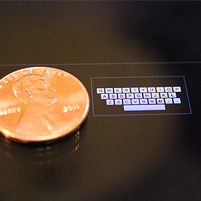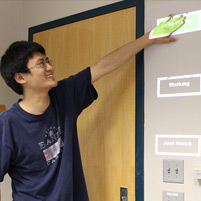(Inter)Facing
Zoomboard
WorldKit


Robert Xiao
Functional touchscreens that can be summoned at will — on any surface. A usable keyboard the size of a penny. Innovations like these are all in a day's work for researchers at Carnegie Mellon University's Human Computer Interaction Institute (HCII).
These two projects were recently presented at CHI 2013, the premiere international HCI conference, held this year in Paris.
Robert Xiao, an HCII doctoral student, was the lead author of the WorldKit project, in which the mere wave of a hand creates a touch-based computer interface.
A user can rub the arm of an easy chair to 'paint' a television remote control or swipe across an office door to see a daily calendar. Extended screens can be pulled down, and screens can be moved or modified with similar gestures.
These feats are achieved with the use of a ceiling mounted depth camera and projector to record room geometries, sense hand gestures and project images.
"WorldKit enables interaction outside the limited confines of displays and mobile touchscreens, putting computation and interactivity anywhere," explained Xiao. "WorldKit is a glance at the possible future of computation, in which computers fade into the background as interactive environments become truly pervasive."
"Putting touchscreens all over your living room would be very expensive, hard to maintain and ugly, but imagine that all your walls were touchscreens, that your desk and every square inch of your office was interactive," added Chris Harrison, an HCII doctoral student who collaborated on both projects presented and recently accepted an HCII faculty position.
Xiao credits the department for helping him with accomplishments like this one.
"CMU is an incredibly supportive environment for high-quality research," he said. "My advisor, Scott Hudson, and mentors like Chris have really helped me gain the skills needed to succeed with research, while the interdisciplinary approach of the department exposes me to great diversity of thought."
The second project, ZoomBoard, led by HCII doctoral student Stephen Oney, allows users to enter text on incredibly small screens, like those used in smartwatches. The research was awarded an honorable mention for Best Paper by the conference.
Conceived by Oney and Harrison during a presentation involving minuscule keyboards, ZoomBoard enlarges individual keys with a simple tap or two, so they can be accurately pressed. A left swipe deletes, a right swipe adds a space and holding types a capital.
"As the devices we build become smaller, we have to think of new ways to operate them," explained Oney. "Text entry on most smartwatches, for example, is clumsy, extremely slow, and in some cases, impossible. With ZoomBoard, we wanted to improve text entry and ultimately, make smartwatches more capable."
Added Oney of his time at CMU, "Being here has allowed me to work with some of the brightest minds in human computer interaction and computer science."
"CMU is the birthplace of HCI and we have people with incredible, varied backgrounds, allowing us to tackle problems that no one else is even thinking about," agreed Harrison, who himself was recently named to both MIT Technology Review's top 35 innovators under the age of 35 and Forbes' top 30 scientists under 30.
"Computers are fantastically amazing tools and the interface is the key to making the most of them — if the fastest machine in the world is unusable, it's useless. With fantastic computer science and HCI departments, CMU actually has the best of both worlds, which is really unique."
"But working with the students," he added, "is a big reason I became a faculty member. It's amazing. I just couldn't give that up."
Related Links: School of Computer Science | Human-Computer Interaction Institute | Press release — ZoomBoard | Press release — WorldKit
